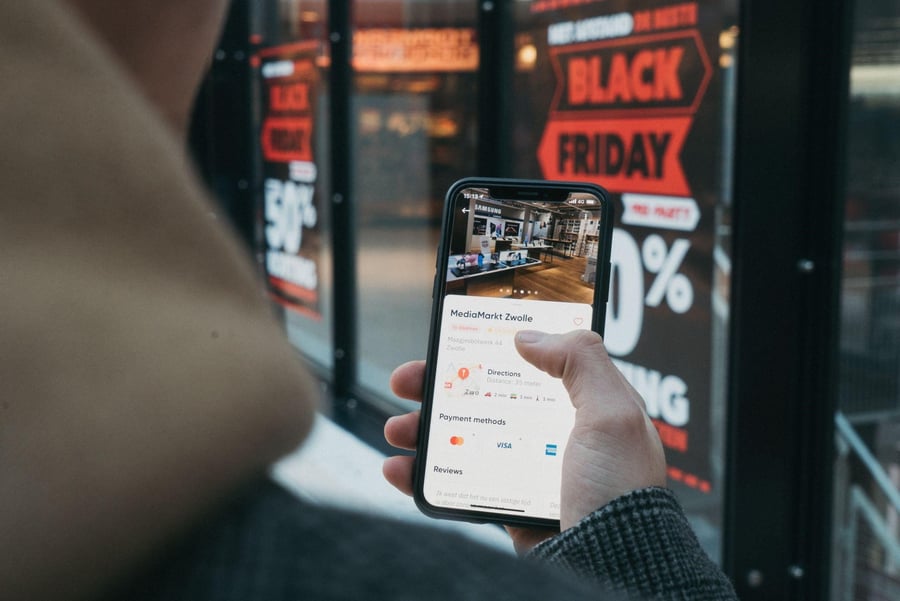
Contextual commerce can be a huge asset in your business’s overall digital strategy. It’s enabled by technologies that are either already here or are coming down the line. In either case, it’s important to stay ahead of the competition — and contextual commerce can help you do that.
Part of new business management is horizon-scanning: figuring out the ever-changing market you’re in and being ready to pivot as soon as possible. By moving to where the ball is about to be, you can be ready when trends like contextual commerce disrupt the retail industry and move effortlessly with your enterprise digital strategy through the changing market.
Let’s go over what contextual commerce is, what’s driving it, and what technologies will be involved over the next few years.
What is contextual commerce?
Contextual commerce is simply putting buying opportunities in front of the customer while they’re going about their everyday lives. Whether that's browsing Instagram, answering messages on WhatsApp, or even just doing work around the house. But it’s about more than just increasing eCommerce sales through social media.
It’s part of a wider omnichannel strategy that involves using these touchpoints not only as a hook into your website, but turning places like social media, chat apps, or even their living room into places where they can complete a purchase then and there.
If you’ve ever made a purchase from Amazon using the Alexa speaker or you’ve ordered from the Starbucks app before passing through the café, you’ve experienced one of the many seamless experiences contextual commerce can enable for your customers.
And with the onset of technologies like artificial intelligence, internet of things (IoT), augmented reality and virtual reality, contextual commerce is going to become available in even more ways than it already is.
The Value of Contextual Commerce
New waves of contextual commerce have arrived in APAC countries like China before anywhere else. You might have seen photos or videos from China where people scan QR codes with apps like Alipay or WeChat, instantly paying for everything from meals at restaurants to new clothes.
Closer to home, you can get started with contextual commerce through the content marketing you’re likely doing already. If you know your content marketing mishaps and how to fix them, you should have no problem creating valuable and engaging content across all your channels.
But you can make that content work harder for you with shoppable social media posts. Platforms like Instagram have tried to capture some of WeChat’s success by putting the “Buy” button right in the user’s feed as they scroll through your content. TikTok has integrated with some eCommerce companies to allow brands to sell right there in the app where their target audience spends so much time.
The main driver behind the success of contextual commerce on these platforms is that it removes the time and effort required to get from seeing your posts in the feed to hitting “Confirm” on your checkout page. An impulse purchase is impossible if the customer has to go to your eCommerce site, find the product they clicked through for, click “add to cart,” get their wallet, fill in their information, etc. etc.

This is why online retailers invest in eCommerce website solutions like Buy Now, Pay Later and predictive search. Shaving even a tiny bit of friction off of the purchasing journey can make a huge difference to your bottom line when you’re talking about hundreds or thousands of customers a week.
If you’re running an omnichannel customer experience already — with unified data and messaging across all communications channels — contextual commerce is a natural extension of that. With omnichannel customers being 30% more valuable than single channel customers, it’s a worthwhile investment to try and “upgrade” your existing customers to contextual channels like voice assistants and chatbots.
Contextual commerce is becoming more common simply because the platforms can see it’s the future. However, as we’ll discuss later on, there are plenty of ways for you to build contextual capabilities on your own sites and the touchpoints you own.
7 Ways Contextual Commerce Technology is Disrupting Online Shopping
There are a number of key technologies driving the move towards contextual commerce, such as the Internet of Things (IoT), voice assistants, artificial intelligence and messaging app purchases. These technologies enable your business to get closer to consumers in their everyday lives. Internet of Things and messaging apps mean you’re never far away, and AI enables you to anticipate what your customer wants before they’ve even asked.
Internet of Things arrives in the city
When you read “Internet of Things” you might think of smart speakers, lights controlled with software, or internet-connected fridges and garage doors. But with 5G being deployed and sensors getting cheaper every year, IoT is set to leave the home and take over the city.
This might look like vending machines with face recognition or Amazon’s checkout-free Go supermarkets. Either way, it builds contextual commerce opportunities into more and more locations in the customer’s everyday life. The NFC tags and RFID chips powering the iPhone’s contactless payment will move into more and more places. This will give consumers more impulse-purchase opportunities like the kinds we might see in China.
Smart speakers enable instant ordering
Smart speaker platforms like Google Home and Amazon Alexa help brands to build their own “skills,” which are voice-controlled apps that enable users to interact with your company however you’d like them to.
These voice assistants have always been able to set reminders like a shopping list. But data-rich grocery chains like Walmart offer voice-controlled shopping that hooks into their home delivery operations. Payment details are already stored either in Google Home or the user’s Amazon account, which enables instant ordering and payment.
If voice assistants were once a niche market, Amazon has taken care of that. 24% of adults in the USA now own a smart speaker like Alexa or Google Home. And if they don’t have a HomePod on their table, they have the same Siri voice assistant in their pocket wherever they go.
After some regular purchases, the user might look at the smart speaker they use every day and wonder if there’s anything they need to buy from your business. For an advertising spend of $0.00, the speakers become some of the most effective billboards you’re on.
Augmented and virtual reality enable online merchandising
Ecommerce merchandising has long been an issue for online retailers, many of whom just can’t create the window-shopping experience with photos online. But with AR and VR becoming cheaper and easier every year, more and more brands have new ways to show off their wares to online shoppers.
Websites like Pinterest use AR filters to let users try on makeup and hair colors in the app and purchase in just a couple of clicks. IKEA uses AR to let users see furniture in their rooms before they buy. And with technologies like virtual reality and the “metaverse” coming down the line, brands are going to have full 3D spaces to merchandise products online.
And AR isn’t limited to the phone. As cameras and sensors get cheaper, and the software powering AR gets better every year, it won’t be long before you look at a clothing store mirror and you’re wearing a digital copy of an outfit you’d never thought to try.

The next generation of in-app purchasing
In-app purchasing has been a major buying category for the better part of a decade. This makes frictionless payments more accessible with tech like Apple Pay, but you can take it further to create opportunities for contextual commerce.
Brands like Starbucks run their in-app payments through an in-app “wallet” that gives them more insight into customer purchasing patterns. This enables contextual commerce by allowing these companies to send tailored offerings and notifications depending on what they’re doing, making a seamless impulse purchase more likely the more data is gathered.
AI transforms chatbot marketing
Channels like SMS or messaging apps form part of any omnichannel marketing strategy. But increasingly sophisticated chatbots, using technology like Natural Language Processing, are making it easier than ever to talk to customers at a moment’s notice.
Chatbots are traditionally built with a “conversation flow,” which is a tree of possible question-and-answer chains branching out from the first greeting. It’s the next generation of the bot that might greet you on a phone call, asking you to press 1 for the Sales department, 2 for customer service, etc. This lets you design a helpful flow for different use cases and make every word on-brand, but it can’t respond well to unexpected input from the customer.
Natural Language Processing employs real artificial intelligence. Rather than spit out whichever cheery lines you write for it, these neural networks are trained to recognize patterns in text across billions of statistical factors. Banks, for example, are using NLP to automate customer support processes across all their support channels.
Not only does this remove the legwork of having to program your own conversation flows, but it also enables you and the chatbot platform you use to benefit from data and improve with machine learning. As AI is integrated into more back-office work in all industries, we might see AIs that can talk to customers through the chatbot referring to customer data it handles on your server.
In-feed shopping enables instant purchases
One surefire way to make your social posts more shoppable is to turn your best reviews into content. If you’re just starting out, you can push for reviews with initiatives like the Amazon Vine program. This allows you to send products to reviewers for honest feedback.
If your product is good and you’re getting glowing reviews, turn them into Instagram ads and target them based on any audience or customer pain-point mentioned in the review. Targeted advertising doesn’t use any of these fancy technologies, but scrolling through Instagram and finding an ad that speaks to whatever problem you’re facing is as contextual as it gets.
5G speeding up everything
All of these technologies will be enhanced with the rollout of 5G in cities and towns around the world. Despite being up to 100x faster than 4G, it’s not just about making mobile purchases faster and more available on the go.
5G makes it possible for a new generation of sensors and IoT devices to benefit both consumers and businesses, without having to route through WiFi and Ethernet connections. Drone deliveries, home security networks like Amazon Sidewalk, and cars with increasing amounts of data and AI capabilities will be made possible by 5G.
In a world where someone can order a Starbucks from their car with Siri while they’re on their daily commute, the possibilities for contextual commerce are endless.
Looking to the future of contextual commerce
Contextual commerce is already here in the form of voice assistants and shoppable social posts. However, the next few years look set to bring disruptions in the retail sector we can’t imagine. By keeping an eye on the cutting edge of contextual commerce, we can make sure we’re ready to take new opportunities when they present themselves.





Leave a reply or comment below